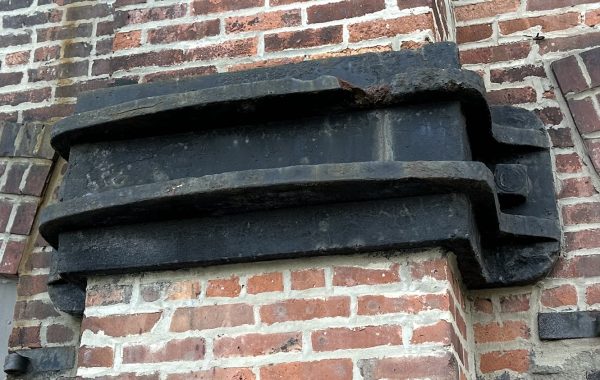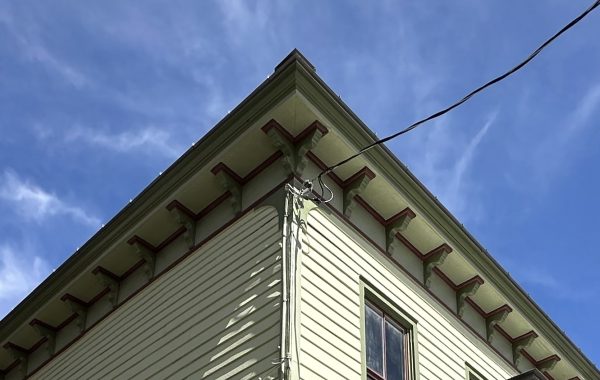I’ve mentioned the Serbian Orthodox Cathedral of Saint Sava before. I’ll be writing it about it this week because we’ve reached an important milestone: there is once again a roof structure on the damaged building. This is not the first step that has been taken toward restoring the cathedral to use, but it is the first that is truly visible to the public. I’ll be describing the damage and the new structures in the coming days. Three years ago, in the blog post that I linked to above, I said that the building was a complete loss. That was not true: the exterior walls survived as did most of the sanctuary floor. These surviving portions of the structure made restoration possible.
The picture above is a piece of debris removed from the building after the fire and left in an adjacent yard. When I first saw it, about a year after the fire, it looked familiar. And then I realized why: the steel is some of my work. My first work at the cathedral was as a consultant to William Stivale, who had been working on restoring the exterior envelope of the building and was concerned about the condition of the roof trusses. Under our old company name, Friedman Structural Engineering, I worked (along with Derek Trelstad) on repairing weathering damage to the trusses. The ends of the trusses, where the pseudo-hammerbeams met the top chords, were partially rotted from leaks in the roof gutter directly above. The wood was damaged and the damage had allowed the truss ends to shimmy a bit sideways (along the length of the building). One of the most important parts of the project was that the overall budget had been based on the exterior stone and roofing repairs, so the structural work had to be as inexpensive as possible. Here’s one of our details from 1997:

(My apologies for the graphics: this drawing was drawn in Generic Cadd (a pretty good DOS-based program), converted to an early Windows version of AutoCad, and more recently convert to Vectorworks. I’m mildly amazed it’s still readable, so the lack of differentiated line weights and a few misalignments are okay with me.)
I’ll point out a single example: at the left end of the mass of charred timber is a small steel semi-cylinder. It’s the furthest left of the brown-colored steel pieces. That’s one of the shoes referenced in the detail above, which held pipe struts that ran from truss to truss to prevent lateral movement. All of the steel in the photo is from our 1997-1998 repair work.
People in the preservation field spend a fair amount of time discussing the effect of time on buildings and the meaning of change to historic artifacts. I’ve done so in this blog. It is a peculiar inversion to see your own work discarded as meaningless when it’s not even twenty years old. Our ’90s repairs were functional, ugly, and cheap, two thirds of which we were asked for, and their loss is not significant. However, their loss in this manner – the entire roof burning and being discarded as debris – is upsetting in a way that their replacement by better repairs would not be. To put it simply: all structures are impermanent, but this was a particularly unsubtle reminder of that fact.
Tomorrow: happier times for the cathedral.




You must be logged in to post a comment.